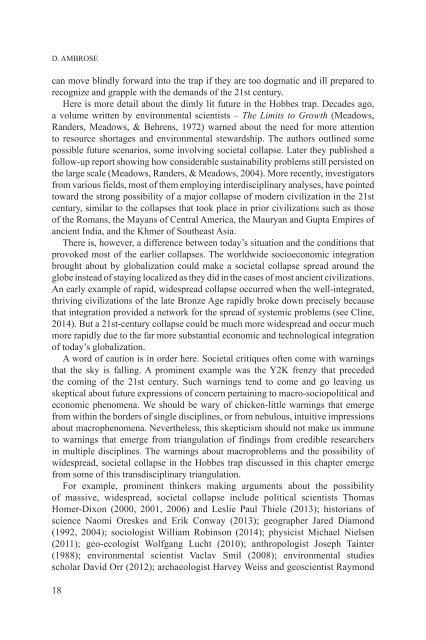Giftedness and Talent in the 21st Century
2739-giftedness-and-talent-in-the-21st-century
2739-giftedness-and-talent-in-the-21st-century
You also want an ePaper? Increase the reach of your titles
YUMPU automatically turns print PDFs into web optimized ePapers that Google loves.
D. AMBROSE<br />
can move bl<strong>in</strong>dly forward <strong>in</strong>to <strong>the</strong> trap if <strong>the</strong>y are too dogmatic <strong>and</strong> ill prepared to<br />
recognize <strong>and</strong> grapple with <strong>the</strong> dem<strong>and</strong>s of <strong>the</strong> <strong>21st</strong> century.<br />
Here is more detail about <strong>the</strong> dimly lit future <strong>in</strong> <strong>the</strong> Hobbes trap. Decades ago,<br />
a volume written by environmental scientists – The Limits to Growth (Meadows,<br />
R<strong>and</strong>ers, Meadows, & Behrens, 1972) warned about <strong>the</strong> need for more attention<br />
to resource shortages <strong>and</strong> environmental stewardship. The authors outl<strong>in</strong>ed some<br />
possible future scenarios, some <strong>in</strong>volv<strong>in</strong>g societal collapse. Later <strong>the</strong>y published a<br />
follow-up report show<strong>in</strong>g how considerable susta<strong>in</strong>ability problems still persisted on<br />
<strong>the</strong> large scale (Meadows, R<strong>and</strong>ers, & Meadows, 2004). More recently, <strong>in</strong>vestigators<br />
from various fields, most of <strong>the</strong>m employ<strong>in</strong>g <strong>in</strong>terdiscipl<strong>in</strong>ary analyses, have po<strong>in</strong>ted<br />
toward <strong>the</strong> strong possibility of a major collapse of modern civilization <strong>in</strong> <strong>the</strong> <strong>21st</strong><br />
century, similar to <strong>the</strong> collapses that took place <strong>in</strong> prior civilizations such as those<br />
of <strong>the</strong> Romans, <strong>the</strong> Mayans of Central America, <strong>the</strong> Mauryan <strong>and</strong> Gupta Empires of<br />
ancient India, <strong>and</strong> <strong>the</strong> Khmer of Sou<strong>the</strong>ast Asia.<br />
There is, however, a difference between today’s situation <strong>and</strong> <strong>the</strong> conditions that<br />
provoked most of <strong>the</strong> earlier collapses. The worldwide socioeconomic <strong>in</strong>tegration<br />
brought about by globalization could make a societal collapse spread around <strong>the</strong><br />
globe <strong>in</strong>stead of stay<strong>in</strong>g localized as <strong>the</strong>y did <strong>in</strong> <strong>the</strong> cases of most ancient civilizations.<br />
An early example of rapid, widespread collapse occurred when <strong>the</strong> well-<strong>in</strong>tegrated,<br />
thriv<strong>in</strong>g civilizations of <strong>the</strong> late Bronze Age rapidly broke down precisely because<br />
that <strong>in</strong>tegration provided a network for <strong>the</strong> spread of systemic problems (see Cl<strong>in</strong>e,<br />
2014). But a <strong>21st</strong>-century collapse could be much more widespread <strong>and</strong> occur much<br />
more rapidly due to <strong>the</strong> far more substantial economic <strong>and</strong> technological <strong>in</strong>tegration<br />
of today’s globalization.<br />
A word of caution is <strong>in</strong> order here. Societal critiques often come with warn<strong>in</strong>gs<br />
that <strong>the</strong> sky is fall<strong>in</strong>g. A prom<strong>in</strong>ent example was <strong>the</strong> Y2K frenzy that preceded<br />
<strong>the</strong> com<strong>in</strong>g of <strong>the</strong> <strong>21st</strong> century. Such warn<strong>in</strong>gs tend to come <strong>and</strong> go leav<strong>in</strong>g us<br />
skeptical about future expressions of concern perta<strong>in</strong><strong>in</strong>g to macro-sociopolitical <strong>and</strong><br />
economic phenomena. We should be wary of chicken-little warn<strong>in</strong>gs that emerge<br />
from with<strong>in</strong> <strong>the</strong> borders of s<strong>in</strong>gle discipl<strong>in</strong>es, or from nebulous, <strong>in</strong>tuitive impressions<br />
about macrophenomena. Never<strong>the</strong>less, this skepticism should not make us immune<br />
to warn<strong>in</strong>gs that emerge from triangulation of f<strong>in</strong>d<strong>in</strong>gs from credible researchers<br />
<strong>in</strong> multiple discipl<strong>in</strong>es. The warn<strong>in</strong>gs about macroproblems <strong>and</strong> <strong>the</strong> possibility of<br />
widespread, societal collapse <strong>in</strong> <strong>the</strong> Hobbes trap discussed <strong>in</strong> this chapter emerge<br />
from some of this transdiscipl<strong>in</strong>ary triangulation.<br />
For example, prom<strong>in</strong>ent th<strong>in</strong>kers mak<strong>in</strong>g arguments about <strong>the</strong> possibility<br />
of massive, widespread, societal collapse <strong>in</strong>clude political scientists Thomas<br />
Homer-Dixon (2000, 2001, 2006) <strong>and</strong> Leslie Paul Thiele (2013); historians of<br />
science Naomi Oreskes <strong>and</strong> Erik Conway (2013); geographer Jared Diamond<br />
(1992, 2004); sociologist William Rob<strong>in</strong>son (2014); physicist Michael Nielsen<br />
(2011); geo-ecologist Wolfgang Lucht (2010); anthropologist Joseph Ta<strong>in</strong>ter<br />
(1988); environmental scientist Vaclav Smil (2008); environmental studies<br />
scholar David Orr (2012); archaeologist Harvey Weiss <strong>and</strong> geoscientist Raymond<br />
18



